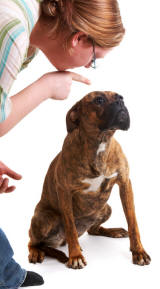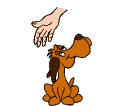No physical
punishment
 To
develop an ideal dog personality, it is very important that no
physical punishment be applied - no exceptions. This is
true for the entire life of the dog. Never spank, slap,
shake, force the dog over on his or her back, or do anything the dog
might perceive as a threat or as aggressive.
To
develop an ideal dog personality, it is very important that no
physical punishment be applied - no exceptions. This is
true for the entire life of the dog. Never spank, slap,
shake, force the dog over on his or her back, or do anything the dog
might perceive as a threat or as aggressive.
Physical punishment often leads to a fearful personality, anxiety,
and behavior problems later in life. Dogs that have been hit will
cower and shy away when your hand reaches out to pet them. Physical
punishment can cause a particular type of aggression, called
defensive aggression. When the dog does not understand why he or she
was physically punished, the dog responds in self protection and may
become aggressive towards people.
Physical punishment, as well as
doing anything that the dog perceives as threatening, may lead to
fear biting and submissive urination.
|
Reward any and all good
behavior to raise a dog that
looks to his or her human as
leader and source of all
good things. |
Interrupt,
redirect and reward
 If
the dog needs correction,
interrupt the inappropriate
behavior. Verbal correction is
acceptable but only if the dog
is caught in the act
of doing the inappropriate
behavior. A "correction"
(not punishment) means to
interrupt the inappropriate
behavior (such as saying, "off"
when the dog jumps on you),
communicate the correct behavior
(redirect) (such as
telling the dog to "sit"), and
then reward correct
behavior by saying, "good dog"
and offering treats
intermittently.
If
the dog needs correction,
interrupt the inappropriate
behavior. Verbal correction is
acceptable but only if the dog
is caught in the act
of doing the inappropriate
behavior. A "correction"
(not punishment) means to
interrupt the inappropriate
behavior (such as saying, "off"
when the dog jumps on you),
communicate the correct behavior
(redirect) (such as
telling the dog to "sit"), and
then reward correct
behavior by saying, "good dog"
and offering treats
intermittently.
If the dog is chewing on
one of your things, verbally
correct the dog with a quick,
sharp sound like a clap, or word
such as, "No." If the dog
drops the item or moves away
from it, say, "good dog".
Find chew toys that the dog in
interested in chewing. Praise
any interest in the chew toy.
The rule is "praise what you
want and interrupt what you
don't want." One way to
redirect the dog from doing the
wrong thing is to
give the dog the
right thing to do such
as asking the dog to "sit."
|
Prevent
your dog student from
learning bad habits by
interrupting inappropriate
behaviors, teaching desired
behaviors, and praising the
behaviors you want to
continue. |
As your relationship develops,
the dog will increasingly seek out opportunities to
please you and will take great delight in simple
verbal praise and attention.
The rule of thumb is to find at least five things
to praise for every one correction given.